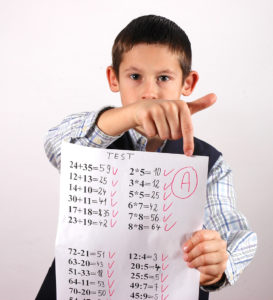 There is no special spell or magic potion to improving student performance. It takes a lot of very hard work of long days and short nights…and maybe a glass of wine now and then.
There is no special spell or magic potion to improving student performance. It takes a lot of very hard work of long days and short nights…and maybe a glass of wine now and then.
Year 1: Stop the Bleeding
I arrived in August 2016 as the new superintendent of Buckholts ISD, a district with a single K–12 school based in Buckholts, Texas, just in time to create a budget and do the August staff development. Realizing the district was a four-year Improvement Required district, I trained the instructional staff in The Fundamental 5 (thinking that was the fastest way to cover a majority of Marzano’s essential elements), implemented a new lesson plan template, and had the teachers take the released STAAR and EOC tests for their subject areas. Region 6 offered TEKS Resource System curriculum training and support for the teachers and helped them create strong lesson plans. Region 6 also started sending specialists to help teachers with planning and classroom support. I started doing daily classroom visits, and we all disaggregated assessment data together.
Region 6 procured computers for us from the TDCJ Wynne Unit Computer Recovery Facility in Huntsville, and we established two computer labs for our middle school students. Discovering most of our middle and high school students were 3–5 years below grade level, we purchased programs to help us with math and reading skills and reworked the schedule so each student had at least one class of reading/math computer lab time with teacher support. The teachers were asked to work with each individual student to create Individual Academic Plans.
In the fall, Texas Education Commissioner Mike Morath sent us a letter stating we would be permanently closed on July 1, 2017, and he granted us an “informal review” to plead our case. We called an SOS (Save Our School) meeting with the community, State Representative Terry Wilson, Michael Holland and Steve Johnson (Region 6 executive and deputy directors), Marsha Ridelhuber (our conservator), Cheri Hart (PSP), and Tom Maynard (member of SBEC) and explained where we were, how we got there, and what our plans were to get out of the “hole” we were in. We told the community what each of us was offering and what we would need from them to be successful. We were able to receive a two-year accreditation abatement agreement from the commissioner, the second year dependent upon our students making significant progress in the Spring 2017 testing. This came in January.
There were teachers who weren’t teaching at all, some who were working hard, and some who needed support. To tell us where we needed to start strategically, Region 6 came out and did a school effectiveness program audit. We made adjustments based on their findings, and the board approved the money to hire “replacement teachers.” I was able to hire a master high school English teacher and a part-time master science retire/rehire teacher. They took on English I and II, Biology, and eighth-grade Science. From January until testing, we worked from early morning until late at night, trying to help the students understand they were worthy of our time and effort. You see, the students had been beaten down by a revolving door of teachers, low academic expectations, and the belief that Buckholts students couldn’t learn, compete, or succeed. It took a lot of “bandages,” tears, frustrations, long workdays, short nights, and a few small successes to show them they could make progress.
In 2017, our scores we were still Improvement Required, but we improved enough to convince the commissioner to give us another year of abatement.
Year 2: Diagnose and Treat
We had another SOS meeting (we called it “Sink Or Swim” this time) to let the community know we were not going to close yet; we had another year of the abatement agreement, but we had to meet standards this year or we wouldn’t get another chance. (Of course, I had already talked to the commissioner about how research shows it takes three years to effect significant change in a school culture and I’d probably need that third year. He said, “No promises. We’ll see…”)
We started the second year much like before, with a few significant exceptions: We were able to keep most of the staff we needed and to add another part-time retire/rehire to act as an instructional coach/reading specialist for our middle school. (The middle school reading levels were still 2–4 grade levels below where they needed to be.)
In October 2017 and January 2018, Ruby Payne graciously agreed to present to our teachers A Framework for Understanding Poverty and Research-Based Strategies on the two Saturdays she had available that year. It was unbelievable training for my little staff, and they took it to heart. One of the things Dr. Payne suggested to us at the administration level was to conduct student progress meetings every other week, during which the teachers, the principal, and I would sit down and go through the latest assessment data we asked the teaches to bring. We did that.
In our meetings, we celebrated successes and discussed reasons and remedies for each student who was still struggling. We went over lesson plans and made changes where necessary. We celebrated every success we could find with the students and with the staff. As a staff, we revisited Ruby Payne’s trainings, and we shared frustrations, suggestions, and celebrations. We had to concentrate on the progress we made and not on the end goal because the end goal sometimes seemed way too far away. But as the year progressed and we kept plugging along, the students started to see their growth.
The teachers taught grade-level material in class and monitored the use of online programs to fill in the learning gaps. It was slow going, but by keeping up with their goals and progress, the students were able to see some successes. It was another year of tears, frustrations, long workdays, short nights, and a lot of moral support from Region 6, our conservator, Terry Wilson, Tom Maynard, and our PSP. We supported our teachers with everything special we could afford: Sonic drinks on Fridays, salad lunches, supplies, etc.
We came out of Improvement Required in 2018 with a C+ (77).
Year 3: Individual Prescriptions, Consistent Monitoring, and a Culture Change
With a 77 under our belt, our community meeting this time was a COS (Celebrate Our Success) meeting, and we celebrated! Hot dogs and street dance and a visit from Tom Maynard to pat us on the back! When I said, “We can’t stop here. We need to continue our forward momentum,” one of the students said, “That’s okay, Mrs. Sandlin. We’ll make a B next year!”
For August staff development, we were lucky enough to have Dr. Payne back to train us on her book Emotional Poverty. It spoke directly of our students, and we referred to that book often during the school year. We also started an NHS program, improved our dual credit program, and began offering AP English to our high schoolers. Almost all our teachers stayed with us, and we saw students returning with expectations of their own, both in academics and athletics.
2018–2019 started with a lighter load and a more relaxed atmosphere, as you may imagine. Being out of Improvement Required status took a lot of the baggage off our shoulders. We continued to push, prod, and pull, but we were able to breathe as we did it. We continued to require a math lab and a reading each day in middle school, but we added electives for them, too. We brought in another part-time retire/rehire for our student support, and we continued to keep our reading interventionist.
Since many of the high school students had jumped on the train and started believing in their success, our focus was on middle school and elementary. We continued to hold the student progress meetings, kept the computer lab periods for all students not on grade level, and had students draw their future stories and set their goals—both short- and long-term. We started seeing a lot of success.
We had so many wonderful things happen this year, but for me, the ultimate achievement occurred this April. Steve Young, our county judge, put together a moot court competition for all the schools in the county. He was able to get the lawyers and judges living and working in the county to work with the students to help prepare them for the contest. Our students, having no debate background at all, worked extremely hard to prepare. We ended up sending three of the four teams to the final round, and we won second place in the competition. It was then that one of the students turned to me and said, “You know, Mrs. Sandlin, we can win. I was always told we couldn’t compete against the bigger schools, that they were smarter, and stronger, and better than we are. But we can compete…and we can win!” We’d turned the corner. I cried.
This summer we learned our student who thought we’d “make a B next year” was wrong. Our preliminary A–F rating this year is an A (89.8, which rounds up to a 90). If you come to visit us, you’ll think we are all crazy because we can’t quit grinning!
Year 4: Reaching for the Stars
Our high school students are in Advanced Placement and dual credit classes, UIL competitions, and CTE programs for certifications. They are winners. And their enthusiasm for learning is permeating the middle and elementary levels. I am so very proud of our teachers and students, who have worked day and night, weekday and weekend, to do what everyone said couldn’t be done.
In Buckholts, we make dreams come true. All it takes is hard work and a relationship with students. Will you join me in celebrating success?
Nancy Day Sandlin is superintendent of Buckholts ISD based in Buckholts, Texas. She has a strong background in education. Sandlin spent 28 years as a teacher in classes from pre-K to high school: two years in Lockhart at Lockhart High School, 11 years teaching pre-K in Kerrville at St. Peter’s Day School, and 15 years in Ingram teaching 6–8 ELAR at Ingram Middle School. From there Sandlin worked in Victoria as a School Improvement and Leadership Specialist at Region III Educational Service Center. She was able to work with 40 schools in the region and helped several get out of accountability trouble. Sandlin then moved to Edna to work as their director of curriculum and instruction for four years and as the assistant principal at Edna Elementary until June 2016.








